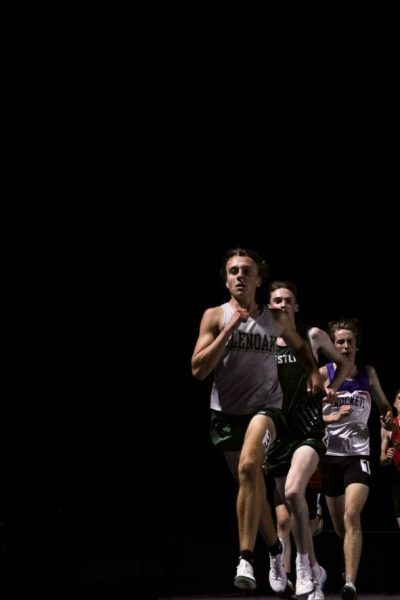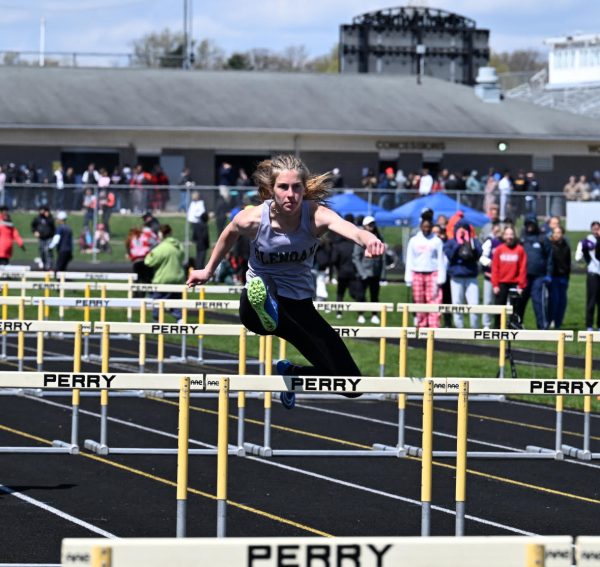The pain within the game
Silence can be heard through this photo of an ambulance on the field after Hamlin’s collapse. Eagle photograph by Schetm, distributed under a Creative Commons Attribution-ShareAlike 3.0 Unported License.
On April 18, Buffalo Bills player Damar Hamlin was cleared to return to playing football after a three and a half month hiatus due to an unthinkable accident on the field.
During a Monday night Football game against the Cincinnati Bengals on Jan. 2, Hamlin tackled opposing player Tee Higgins, taking the pair to the ground at full force. Following the impact, Hamlin collapsed, entering cardiac arrest. This was devastating to watch from the sidelines, in the stands, or at home.
“I died on National TV, in front of the whole world.” Hamlin said at his press conference in New York on April 18.
Throughout the timeline of this incident, the question has developed as to just how serious these injuries are to youth athletes. Which leads to the inquiry if GlenOak players and students feel that the game is worth the pain.
Senior Dominic Leon plays football at the high school and is committed to play collegiate level football at Walsh University. Inevitably he has seen his fair share of injuries on the field.
“I think anytime someone was injured they handled it very well. Football is one of those sports where you have to be tough, but I think it is important to be aware of when enough is enough, and they do a good job of recognizing that,” Leon said.
It is no secret that high impact sports such as football are going to produce injuries of all levels. However, there are ways that many youth athletes can prevent these injuries from becoming life threatening.
“Youth athletes can prevent injuries by having the right form, being aware of everything while out on the field, wearing the proper gear, and having proper preparation in terms of stretching and nutrition,” Leon said.
Although athletes may try their best to prevent getting hurt during games, some injuries simply can not be avoided. Trainer Alex Shaheen and his team are the ones who respond to field injuries at GlenOak football games.
Shaheen discussed the Damar Hamlin incident at length with his students. He used it as a perfect example of an emergency action plan for his students to look at and keep in mind during their time on the sidelines.
“Many athletes assume the risk of the sport when they participate. It is always a matter of if the reward of participating outweighs the risk. Whatever that award is, whether its status, scholarships, or pure competition, it often outweighs the risks for many parents and athletes,” Shaheen said.
High school football is not the only place where injuries are a topic of discussion. The United States Football League’s (USFL) New Jersey Generals Offensive Lineman Saige Young has had experiences with injuries on the field himself.
Young’s first major injury outside of high school occured when he was in his sophomore year at Vanderbilt University when he tore a ligament in his right ankle. This injury took him off of the field for the remainder of the game. However, he didn’t let this crush his spirit and drive.
“I will continue to play football for as long as my body allows me to, despite all of the injuries that have occured or will potentially occur…I have one goal in mind and that is to play in the NFL. Second, my love and passion that I have for this game is unmatched,” Young said.
As someone continues to play high-contact sports, they have to be prepared for any kind of injury, as well as how to deal with them. High school football games are not the only games with Athletic Trainers and medial teams, which Young calls the backbone of his football team.
“Without them [The team’s Athletic Trainers] we wouldn’t have any players ready for game day. The amount of time they put in to help us stay or get back on the field is astronomical. We appreciate everything they do for us.” Young said.
With any kind of injury, whether it be sports related or something else, recovery is the most important part of healing. Sometimes, it can be difficult for players to take time off of the field, but it benefits them in the long run by keeping them healthy enough to continue playing to their fullest extent.
In addition to recovery, players must continue to tend to their bodies and keep themselves healthy during their off seasons so that they can get right back on the field when the time comes around.
“We must take care of our bodies so our bodies can take care of us.” Young said.
The medical anomaly suffered by Hamlin is called commotio cordis, which is cardiac arrest that is caused by a direct blow timed at a specific point in your heartbeat. Commotio cordis is the leading cause of death in youth athletes across numerous sports, which makes it a rising concern for young athletes as well as their families.
“My heart is still in the game. I love the game…I just want to show people that fear is a choice and you can keep going in something without knowing what’s at the end of the tunnel. You might feel anxious or any type of way but you just keep putting your right foot in front of the left foot and you keep going,” Hamlin said in his press conference preceding his return.
Hamlin properly captures the mindset of many youth athletes across the world. It is true that there are risks involved in the game, but it is the drive and passion of these players that keeps them going.
Your donation will support the student journalists of GlenOak High School. Your contribution will allow us to purchase equipment and cover our annual website hosting costs.

Pressley Grzybowski is a senior and 4th year staff member. As well as her participation on staff, she is the student council executive secretary, the president...






